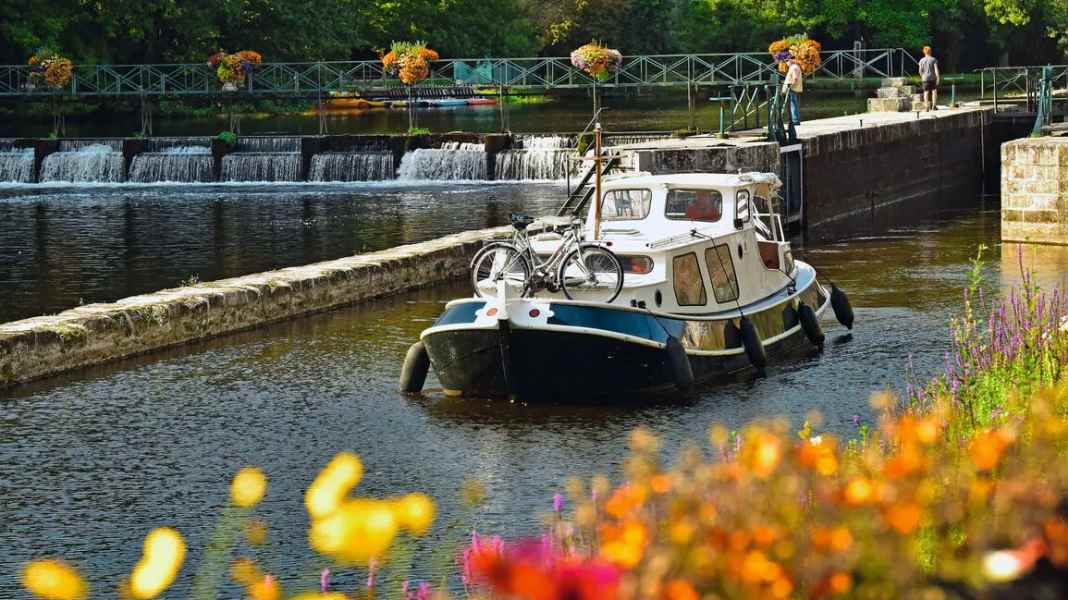
The word Brittany conjures up images of rugged rocky coasts, needle-pointed cliffs in the ocean and lighthouses surrounded by the sea, defying the waves of the Atlantic like fortresses. Painters such as Maurice Denis and Paul Gauguin set up their easels here, and the marine photographer Philip Plisson found his most impressive motifs of the unbridled power of the ocean on the Breton coast. With a coastline of 2700 kilometres, the power of the sea can be felt everywhere on the Breton peninsula. Anyone who goes to sea here experiences the ocean in its elemental rigour. Bretons have been considered France's best sailors for generations. The greatest French naval hero Éric Tabarly was also - how could it be otherwise - a Breton.
Less well known is the fact that the western nose of France is criss-crossed by over 500 kilometres of navigable rivers and canals. These waterways are not connected to France's network of inland waterways. The Breton canals stand alone and connect the peninsula's major seaports. The fact that these canals were built at all is thanks to the arch-rival England, which threatened Breton coastal shipping in armed conflicts. The impressive canal system was intended to connect St Malo on the English Channel with the seaports of Lorient, La Roche-Bernard and Nantes in the south of Brittany. Another branch canal led westwards into the Gulf of Brest.
Construction of the canal system began in 1811 under Napoleon I and was completed in 1858 by Napoleon III. A total of 238 locks overcome a height difference of 555 metres. At the end of the 19th century, the canal experienced a brief economic boom. The rapid expansion of the railway and road network led to the decline of freight shipping. In particular, the dense succession of locks and the resulting slowness meant that inland shipping was no longer competitive. Finally, in 1928, the construction of a hydroelectric dam at Guerledam cut off the western part of the canal system in the direction of Brest and accelerated the decline of inland shipping.
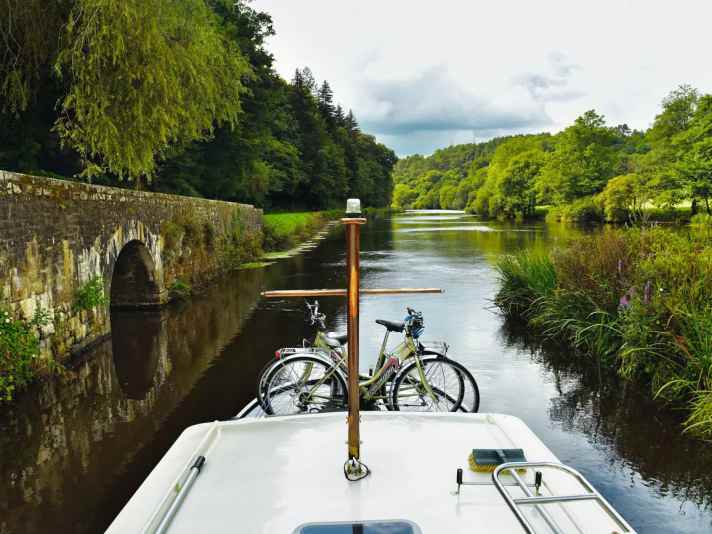
If you take a boat out on the inland waterways of Brittany today, you will be alone for long stretches. But this loneliness is hardly a bad thing, as you are rewarded by a magically beautiful landscape that slows every boater down.
Once you have cleared the lines after the lock and nodded to the lock keeper, who overtakes the boat in a small car on the towpath, you can already see the next gates ahead. There is no time to hurry. And at the latest when the lock keeper says "Assez pour aujourd'hui" as the sun sets low, you know it's time to relax and uncork the Bordeaux - no matter how remote the mooring is.
In the picturesque small town of Saint-Nicolas-des-Eaux, where the river Blavet describes the "Circuit de méandre", turning 180 degrees in a hairpin bend, lies the charter base of the small family business Brittany Boating. The friendly owners Simon and Clare Curwen are British and the name Brittany is the English word for Brittany. On the banks of the river at Saint-Nicolas-des-Eaux, thousands of chrysanthemums bloom in countless flower pots, shining in all colours. The weir next to the lock makes a constant noise - as you can hear in almost every village along the river.
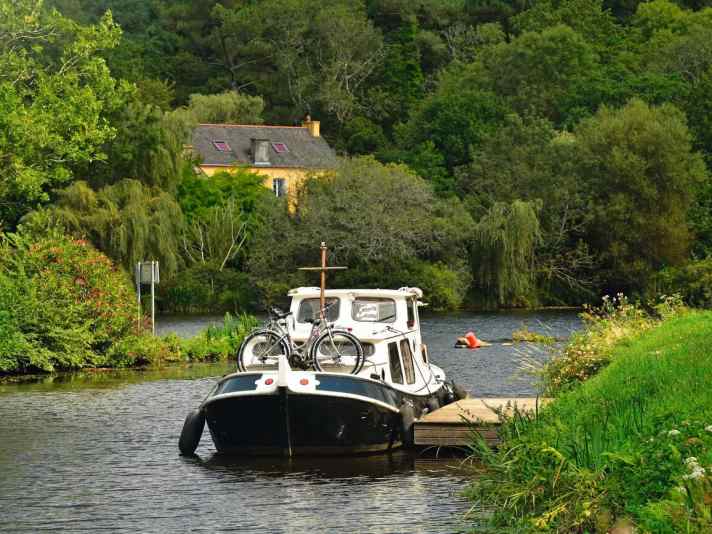
From Pontivy, where the Canal du Nantes à Brest branches off, the Blavet is navigable for around 58 kilometres to the south and is regulated by 28 locks. South of the 28th lock near Hennebont, a suburb of the seaside town of Lorient, the tides of the rough Atlantic already determine the water level. Saint-Nicolas-des-Eaux lies roughly in the centre of the navigable part of the Blavet. Consequently, there are only two directions in which you can travel: either upstream to Pontivy or downstream to the ocean.
Like all strangers, we have a bit of an orientation problem in Saint-Nicolas-des-Eaux, because the Blavet first flows south and then, after the "Circuit de méandre", parallel to it and 100 metres to the north.
Brittany Boating's four charter boats are moored on the picturesque waterfront of the small town. The "Antares" we hired is an eleven-metre-long tjalk, which was launched in the Netherlands around a hundred years ago as an inland cargo ship. Originally, this type of iron boat was sailed. It was used to transport agricultural products and was only partially covered. Our Tjalk is of course completely covered and converted into a cosy cabin boat. It is powered by a modern 45 hp diesel engine that only guzzles two to three litres per hour. You can't compare the living space on an old tjalk that you have converted yourself with the comfort of a modern Dutch steel yacht. The old lady undoubtedly has her charm, but if you are looking for a luxury charter yacht, you are in the wrong place.
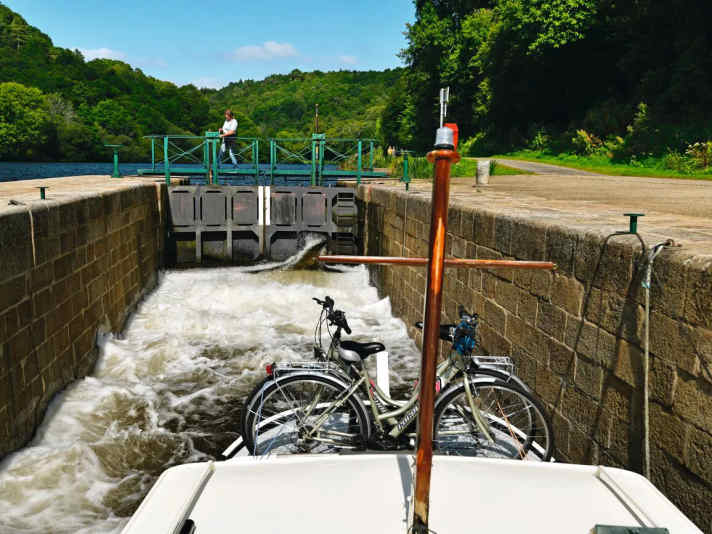
Simon and Clare Curwen are passionate sailors and love old ships. Their fleet includes another Tjalk and two classic Dutch steel displacement boats. Our little ship is quickly explained and, as expected, the technology is straightforward, as there are no modern bells and whistles.
"In one charter week, you manage to travel both uphill to Pontivy and downhill to Hennebont. Over 58 kilometres, you have 28 locks ahead of you. Since you want to get back safely, both figures are of course doubled."
"Is it better to go up or down first?"
"It doesn't matter at all." We decide to head downhill towards the Atlantic first. After we've done our shopping and stowed our provisions, Simon calls the lock. A young woman comes rushing up in a Renault Twingo. "I'm Babette, your lock keeper for the day." At 2 p.m. we untie the mooring lines, steer through an old stone arch bridge and are already in the "Circuit du méandre". In the hairpin bend, there is a towpath on the left bank where joggers and bikers do their laps. Suddenly, a white Twingo comes shooting along the narrow path, Babette waves from the open window. The hairpin bend is not over yet, as we see her cranking again at the gates of lock N°10 La Couarde.
After the hairpin bend, we are back in Saint-Nicolas-des-Eaux - just a hundred metres parallel to the riverbank from which we set off. But then we take a sharp left turn and head south, where Babette is already cranking away at the next lock. She is a student and only does the job on the side. A kilometre further on comes the third lock. Babette is so exhausted from the hard labour that I get out and help her. She calls her colleague Michel, a muscular young man, on her mobile phone. He is also a student, but has been working as a lock keeper for some time. It's quicker with two people.
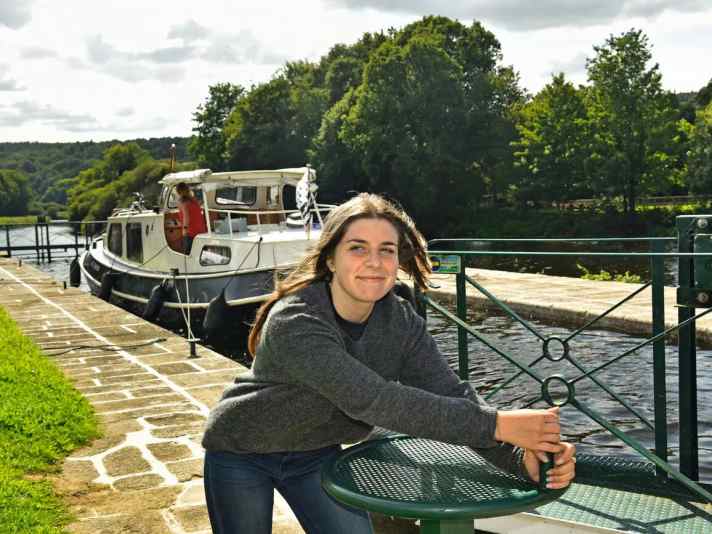
Lock after lock follows each other all afternoon until we enter N°19 Minazen at around 6.30 pm. The two students lock us down there, but let us know that we've had enough for today. We moor in the tailwater in front of the Glaces bar, where the inhabitants of the neighbouring villages meet for an evening wine.
With a growling stomach, I ask the bar owner what she can make us to eat. She proudly shows me the Schöller ice cream menu. Without further ado, we get baguettes and cheese from the boat and order red wine, which is served from a cardboard box. But the lower the sun sinks and the more often it is topped up, the better the red wine tastes.
In the morning, we push our bikes over the Minazen weir and cycle about one and a half kilometres to the historic Village de Poul-Fetan. The mini village is a unique ethnological museum. Here you can learn very vividly how the villagers lived and worked around a hundred years ago. Visitors can watch bread being baked or spinning and weaving. A whole field of hemp grows as tall as a man in the centre of the village. Unbelievable! It smells like a joint. The cannabis leaves from this field would be worth a fortune on the black market.
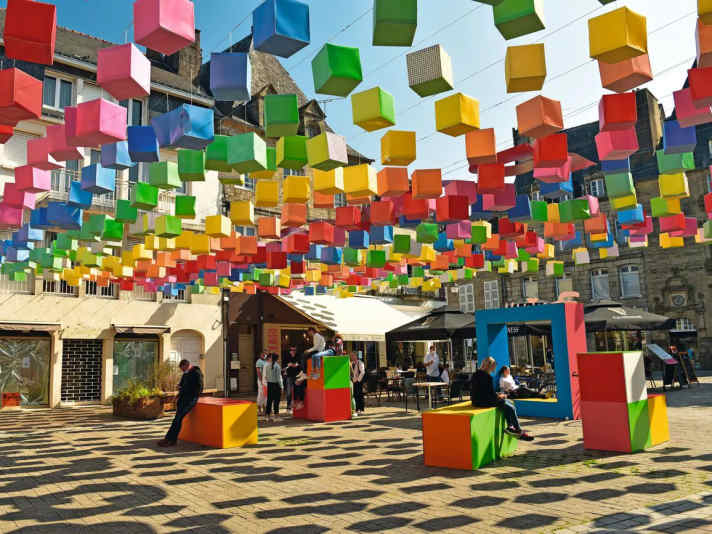
In the Village de Poul-Fetan, visitors learn that hemp was not smoked as hashish in the past, but that its fibres were used to make ropes for the rigging of sailing ships. With the smell of fresh hemp in our nostrils, we cast off at 2 p.m. and shortly afterwards steer into lock N°20 Manerven. Four hours later, our descent ends in front of lock N°28 Polvern. Theoretically, we could continue towards the Atlantic, but in practice this is not possible at this hour. Looking over the lower lock gate, you can see a stony riverbed that you could wade through with your trouser legs rolled up. This is where the tidal waters of the Atlantic begin, and we are at low tide.
We calculate that we will have high water at midnight, but then the lock keepers are asleep. The next high water would be at midday the following day. But then we wouldn't be able to get to the jetty in the nearby village of Hennebont because there are two low bridges on the way there and we would have to wait for low water again in front of the bridges. That would take a lot of time.
But we still have an alternative on board, so we moor our boat in the upper water in front of the lock, get on our bikes and cycle along the towpath along the Blavet to Hennebont in a quarter of an hour.
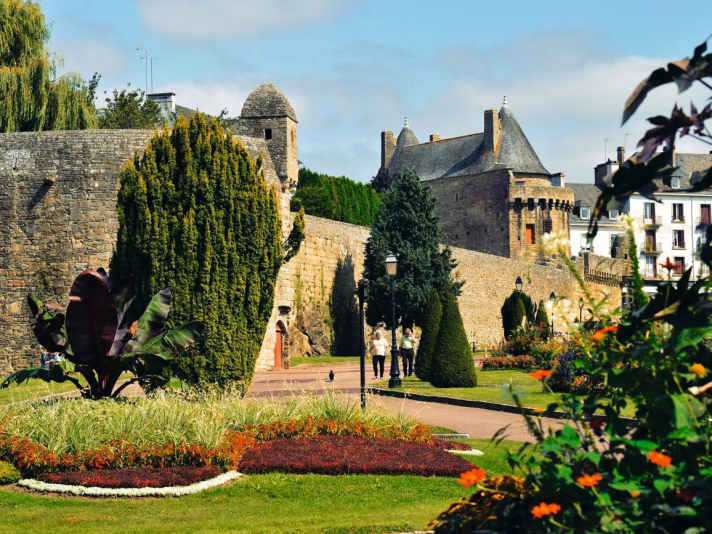
Although the municipality of Hennebont is already influenced by the Atlantic tide, it is another sixteen kilometres to the mouth of the Blavet into the ocean. On the western bank of the estuary lies the large seaport and harbour town of Lorient. Hennebont was bombed during the Second World War. However, parts of the old town centre around the Notre-Dame-de-Paradis cathedral have been rebuilt and form the heart of the town, which is well worth seeing.
In the morning of the following day, we do our shopping by bike in Hennebont, cast off again at our southernmost point before lock N°28 Polvern and start our ascent back north at 1.40 pm. Thanks to a new and very experienced lock crew, we make it to lock N°19 Minazen by 7.30 pm. Then the lock team is no longer willing. We travel a little further and enter the underwater section of lock N°18 Sainte-Barbe.
This lock is also known as the flower lock by the locals because of its lush floral splendour. From here, it's just a few metres to a campsite and the pretty waterside restaurant Au Rendez Vous Des Pechers. The campsite is deserted and the restaurant is closed. We learn from an angler that the holidays in France end on 1 September, which means that all the tourist facilities on the canal are closed.
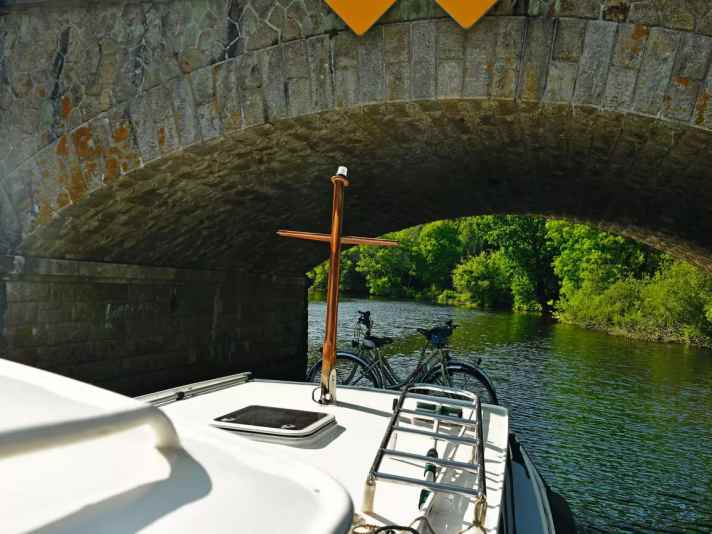
At 9.30 in the morning, our friendly lock team opens the gates of N°18 Sainte-Barbe. We have 17 locks ahead of us to Pontivy, the highest point of the canal. We have just under nine hours to get there. It will be an exhausting but also beautiful day. On average, we enter a lock every half an hour, are locked up in a few minutes thanks to a fast-working team and meet the same team again minutes later at the next lock, which is already prepared for us. The landscape is evenly beautiful. All around us are deciduous forests, between which the canal meanders. The lock keeper's cottages and the former water mills at the rushing weirs are the dominant structures.
The landscape changes in the evening. We reach the suburbs of the town of Pontivy, the upper destination of our journey. At around 6 p.m., we pass the highest lock of our trip: N°2 Lestitute. Above the town of Pontivy is lock N°1 Recollets, which leads to the Canal de Nantes á Brest.
On the recommendation of our lock team, we moor in the upper water and take a few steps across a field to go shopping in Pontivy's largest supermarket. Once the catering has been stowed on board, we sail the last two kilometres uphill to the centre of Pontivy. We like the town. Both banks of the canal are lavishly decorated with flower boxes. The centre is dominated by beautiful old buildings in well-kept condition.
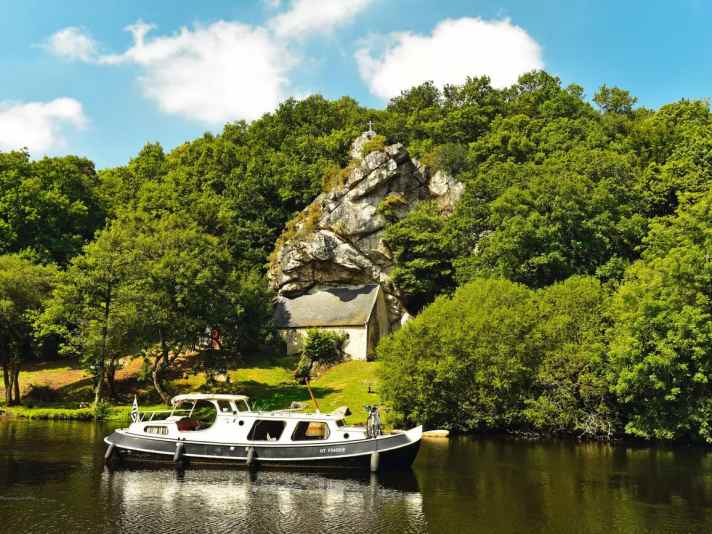
We discover a municipal jetty on the west bank, where we go alongside. There is even electricity and water. The old town island now lies in front of our bow, with the Auberge de l'île perched on its dominant tip and illuminated by the most beautiful evening light. If that's not an invitation! We spontaneously go into the restaurant, even get the best terrace seat with a view of our boat and enjoy the freshly prepared perch from the Blavet.
Our morning walk confirms the impression from the previous evening: Pontivy is a beautiful and well-kept old town, and you should take half a day to wander through the picturesque alleyways up to the Notre-Dame de Joie basilica.
We say goodbye to Pontivy at 1.45 pm. Travelling with us again in a small car is our lock team, consisting of the young Manndig and her older colleague Domenique. We are a well-rehearsed team. Despite all the language barriers, we understand each other very well. Our plan is to make it down the valley to the charter base in Saint-Nicolas-des-Eaux in half a day. There are "only" eight locks on this route. On the way, we see a single boat coming towards us at a leisurely pace.
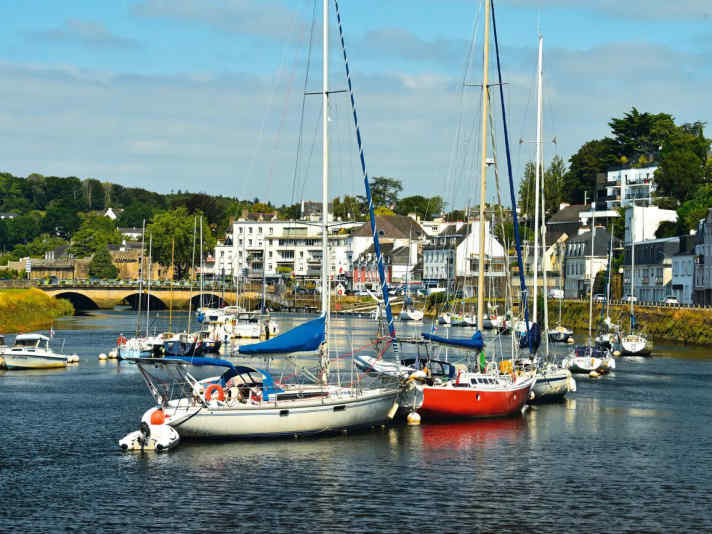
On Thursday evening, we moor at the charter base in beautiful Saint-Nicolas-des-Eaux and have dinner at the crêperie Le Chalet right on the river. We feel a little melancholy as our Brittany cruise is almost over - but only almost.
Our charterer Simon Curwen, who comes from England, is not only a well-known ocean sailor here in Brittany, but also internationally. In September 2022, at the young age of 62, he wants to start the third Golden Globe Race single-handed non-stop around the world. The Golden Globe is considered one of the toughest regattas in the world. When we checked in on his Tjalk for the Blavet trip a week ago, he said: "When you come back, you absolutely have to go to the west coast for a day, to Finistère, where land and ocean meet. You'll feel the soul of Brittany there."
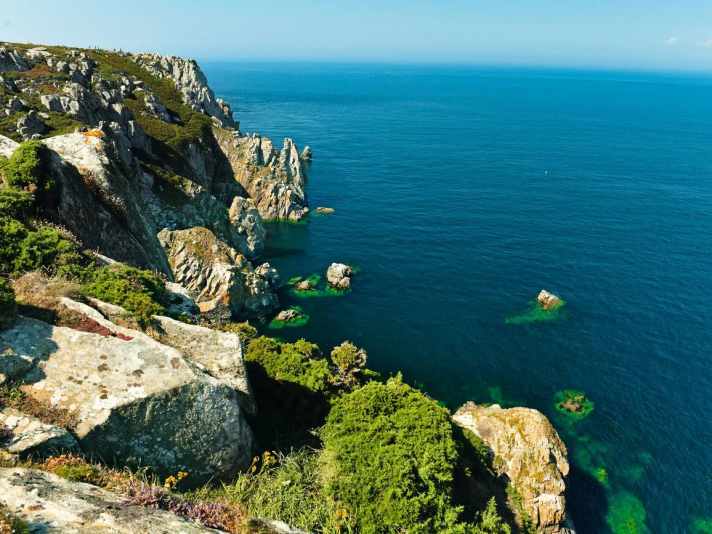
Of course we are happy to take this advice! After a two-hour drive from the charter base in Saint-Nicolas-des-Eaux, we reach the Pointe du Raz headland at Cape Sizum in a hire car. The impressive rocky outcrop points like a finger far to the west into the Atlantic. In front of it, the Phare de la Vieille lighthouse lies in a rock garden of cliffs and four nautical miles further out, the Île de Sein is surrounded by the sea. You can literally smell the sea, and on the cliffs you can feel it under your feet as its breakers vibrate the earth.
The charter company is right, the rocks of Finistère, which means the end of the world, are a truly magical place. And there is nothing beyond it for a long, long time. Because where the sun burns out in the west, there are around 2000 nautical miles of open ocean - all the way to the coast of the Canadian island of Newfoundland.
Service
Cruise stages
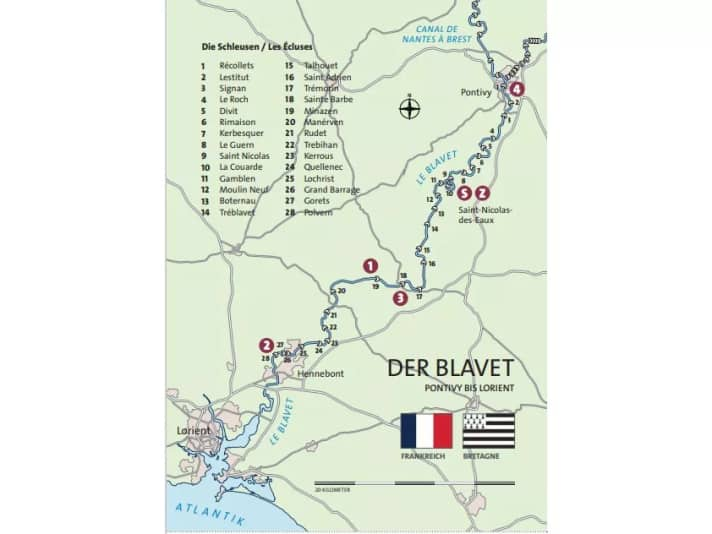
S Saint-Nicolas-des-Eaux-Minazen .............................................. 22.0 km
1 Minazen-Polvern.......................................................................18,8 km
2 Polvern-Sainte-Barbe ................................................................ 22.7 km
3 Sainte-Barbe-Pontivy ................................................................35.6 km
4 Pontivy-Saint-Nicolas-des-Eaux................................................. 17.6 km
Z Total distance.......................................................................... 116.7 km
Literature
On board the charter boats is the "Guide Fluvial 1: Bretagne", a very detailed navigation atlas with local descriptions in French, English and German. Éditions du Breil, for 20.50 euros. Order via: www.hansenautic.de
The tourist information centre in Saint-Nicolas-des-Eaux (located directly opposite the charter base) provides free maps of the region.
Official online waterway guide for the Brittany region with all nautical service information and freely zoomable interactive map: www.canaux.bretagne.bzh/canaux/blavet
Our boatThe eleven metre long "Antares" is a classic Dutch tjalk that has been converted into a motorboat. There is a double cabin fore and aft, a large saloon with galley and a wet room with WC and shower. A bow thruster facilitates manoeuvring in confined spaces.
CharterDepending on the season, the boat costs between 1184 and 1910 euros per week. Fuel and lubricants are charged at a flat rate of 8.00 euros per hour of operation. The deposit is 800 euros. Bookings under: www.brittanyboating.com

The TOP 3 in the district
- Village de Poul-FetanHistoric village where traditional crafts are practised, including the production of hemp rope. About 1.5 kilometres from the Minazen lock.
- Pontivy:Very picturesque small town in the north of the navigable section of the Blavet. This is where the Canal de Nantes à Brest meets the river.
- Pointe du Raz at Cape Sizun: One of the most spectacular cliffs on the Atlantic coast with a breathtaking sunset over the Île de Sein. Located about two hours' drive from Saint-Nicolas-des-Eaux.
Nautical information
The precinct The regulated part of the River Blavet is not very demanding from a nautical point of view. However, you should not go beyond lock N°28 Polvern, as this is where the tidal waters begin. South of Hennebont, the river becomes a sea waterway, for which the boat is not authorised.
Driving licence The entire region between Pontivy and Polvern is licence-free.
Journey The journey from Hamburg to Saint-Nicolas-des-Eaux is around 1400 kilometres, i.e. more than 14 hours by car. A more comfortable option is to fly with Lufthansa via Frankfurt to Nantes, depending on the season from as little as 350 euros for a return flight. From Nantes to Saint-Nicolas-des-Eaux it is 168 km or two hours by hire car. You can get one from around 170 euros a week and then have a vehicle for your trip to the spectacular Atlantic coast

